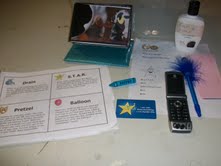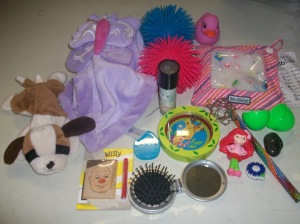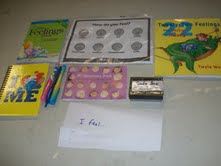Our daughter is ten and has been home with us since May 2010 (with the adoption finalized in Nov.). She’s made huge progress. In the beginning, she would only acknowledge two emotions: happy and mad. Either everything was great and she was sweet, loving, joyful and oh, so desperate to please or she was ANGRY. She would scream for an hour at a time. She couldn’t give any reason for her big feelings other than “You made me mad!” She didn’t want to talk about her feelings or her past. She tantrummed at the slightest correction or gentlest “no”.
I have a background in early childhood education and have worked with at risk preschoolers for years. After several months, it finally occurred to me to try some of what I use with these children at home with my daughter. Though my daughter came to us at 9, she was often stuck at the toddler or preschool level emotionally. I teach preschool teachers to use Dr. Becky Bailey’s Conscious Discipline methods in classrooms. I made copies of some of those materials and brought them home for my daughter.
I stuck a feelings chart in a clear sleeve and put some relaxation exercises together in a little booklet.
I taught her “the balloon” when she was calm. This is a breathing exercise where you put your arms over your head and take a deep breath in while inflating your arms like a balloon. Then you blow the air out (quickly and loudly at our house!) to deflate your balloon.
I realized that she didn’t understand other feelings. She was trying so hard to put on a happy front and when that failed, “mad” was her default. It’s all she knew. I explained to her that mad is a big and loud feeling, so it’s easy for other feelings to hide behind. I started talking about other feelings and asking if they might be hiding behind her mad.
I made her a “Feelings Toolkit”. I gathered up lots of items we had around the house, picked up a few cheap things from the store and taped some handwritten labels on a couple things. I put it all in a plastic storage box and wrote, “(Her Name)’s Feelings Toolkit” on it. We talked about each item in the box, so she had some ideas of how to use it to help her. I tried to include items that she would want to use for a variety of emotional age levels and that would appeal to all her senses.
Items for relaxation and connection:

- An album filled with photos of her with us and some of her biological siblings to remember happier times and that she is not alone
- The booklet of breathing exercises, including The Balloon
- A printed reminder of “You are safe, loved and can handle this”
- Instructions for how to be a S.T.A.R. (Stop, take a deep breath and relax)
- An eraser to “erase” feelings she wants to get rid of
- A book of little notes and a pen to write to people she’s thinking of
- Texas and Florida quarters to represent where she came from and where she is now
- A token from a go-kart place she loves going to with her Dad
- A broken cell phone to pretend to call someone to talk
- Calming Cream Lotion (just regular face cream that I stuck a label on)

- A baby blanket square
- Little stuffed dog
- A variety of handheld puzzles /games
- A mini kaleidoscope
- Some squishy balls
- Silly putty
- A brush (to use on her skin or hair) with a mirror attached
- A little rubber duckie
- A very scented Strawberry Shortcake figure
- A charm that flashes
- A little “I spy” pouch with a clear cover and filled with tiny items hidden in white beads to find. (Sort of like this)
- The feelings chart
- American Girl “The Feelings Book: The Care and Keeping of Your Emotions”
- A notebook and pens for journaling
- A book called “Twenty-two Feelings from Nice to Nasty”
- A book of questions
- A little box that I stuck a label on that says, “Safe Box: For Keeping Feelings You Aren’t Ready to Share Yet”.
- An envelope with slips of paper inside that say, “Today I feel…”
I still tell her she’s safe, loved, and can handle this; whatever “this” is at the moment. I’ve heard her telling it to her stuffed animals and our pets. She taught her best friend to do the balloon.
She had a big melt down in May. It was a doozy that went on and on in waves of screaming, crying, disrespect and defiance. Lots of big feelings hiding behind a giant wall of mad. She packed her laundry hamper full of stuff and said she was running away. She sat in the driveway of the vacant house next door.
She finally calmed down and we got to the bottom of what triggered it and the real feelings attached.
, I was amazed at what I found in there. Her weighted blanket (“feel our love holding you and keeping you safe”), a photo album (to remember happier times), lavender body lotion (to relax and soothe) and a notebook and pen (for writing down thoughts and feelings).
Her words and actions certainly weren’t saying it, but she was trying to calm herself down. She didn’t want to be in that state. She remembered her tools on her own and just needed time to put them to use.
She didn’t write anything in the notebook that day, but as I took photos of the items in the toolkit for this post, I found something she wrote on one of the “Today I feel…” slips of paper. It was dated September 26 (five months after coming home) and said, “Happy, safe, cared for, loved”.
She has had a great summer with few meltdowns. When she does lose her "calm brain", she's able become regulated again pretty quickly - and often on her own! She still doesn’t always choose to use her tools or acknowledge her real feelings right away. She can almost always talk about it after a meltdown now, though. She told me that she’s proud of me because I help her talk about her feelings. We still have a lot of healing ahead of us, but she’s made such huge progress. We have so much hope for her future. And we’re so very proud she’s our daughter!
I think having the Feelings Toolkit has really helped her wrap her head around the concepts of feelings and what to do about them. Even though she rarely brings it out, she's told me how much she likes knowing it's available.
Read more about our older child adoption journey at www.lastmom.blogspot.com


No comments:
Post a Comment
Feel free to leave comments and suggestions. We all love to learn!